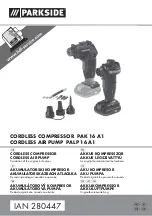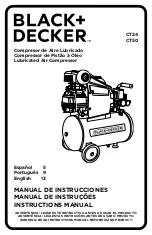
15
GB/IE
Additional safety instructions
Safety instructions for working with compressed
air and blasting guns
• The compressor pump and lines can become very hot during
operation. Touching these parts will burn you.
• The air which is sucked in by the compressor must be kept
free of impurities that could cause fires or explosions in the
compressor pump.
• When releasing the hose coupling, hold the hose coupling
piece with your hand. This way, you can protect yourself
against injury from the rebounding hose.
• Wear safety goggles when working with the blow-out pistol.
Foreign bodies or blown off parts can easily cause injuries.
• Do not blow at people with the blow-out pistol and do not
clean clothes while being worn. Risk of injury!
Safety information for paint spraying
• Do not process any paints or solvents with a flash point be-
low 55° C. There is a risk of explosion!
• Do not heat up paints or solvents. There is a risk of explosion!
• If hazardous liquids are processed, wear protective filter
units (face guards). Also, adhere to the safety information
provided by the manufacturers of such liquids.
• The details and designations of the Ordinance on Hazard-
ous Substances, which are displayed on the outer packaging
of the processed material, must be observed.
• Additional protective measures are to be undertaken if neces-
sary, particularly the wearing of suitable clothing and masks.
• Do not smoke during the spraying process and/or in the
work area. There is a risk of explosion! Paint vapors are eas-
ily combustible.
• Never set up or operate the equipment in the vicinity of a fire
place, open lights or sparking machines.
• Do not store or eat food and drink in the work area. Paint
vapors are harmful to your health.
• The work area must exceed 30 m3 and sufficient ventilation
must be ensured during spraying and drying. Do not spray
against the wind. Always adhere to the regulations of the
local police authority when spraying combustible or hazard-
ous materials.
• Do not process media such as white spirit, butyl alcohol and
methylene chloride with the PVC pressure hose. These media
will destroy the pressure hose.
Operating pressure vessels
• You must keep your pressure vessel in good working order,
operate the vessel correctly, monitor the vessel, carry out
necessary maintenance and repair work immediately and
meet the relevant safety precautions.
• The supervisory authority may enforce essential control
measures in individual cases.
• A pressure vessel is not allowed to be used if it has faults or
deficiencies that can endanger workers or third parties.
• Check the pressure vessel for signs of rust and damage each
time before using. Do not use the compressor with a dam-
aged or rusty pressure vessel. If you discover any damage,
then please contact the customer service workshop.
Do not lose these safety instructions
Residual risk
Observe the specified maintenance and safety instructions in
the instruction manual.
Always be attentive at work and keep third persons at a safe
distance from your workplace.
Even with proper use of the device, a certain residual risk re-
mains, which can not be excluded. The following potential haz-
ards can be derived from the type and design of the device:
• unintentional commissioning of the product.
• Hearing loss if no suitable hearing protection is worn.
• Wear safety glasses to prevent your eyes and face from
dust and dirt particles.
• Inhalation of whirled-up dust and dirt particles.
7. Technical data
Mains connection
230 V∼ 50Hz
Motor rating W
1800
Operating mode
S1
Compressor speed
2850 min
-1
Pressure vessel capacity (in liters)
approx. 50
Operating pressure
approx. 10 bar
Theoretical intake capacity (l/min)
approx. 260
Sound power level L
PA
74.3 dB(A)
Sound power level L
WA
94.3 dB(A)
Uncertainty K
PA/WA
2.37 dB
Protection type
IP20
Weight of the unit in kg
ca. 34
Oil (15W 40) l
ca. 0,25
Max. altitude
(above mean sea level)
1000 m
The noise emission values were measured in accordance with
EN ISO 3744:1995.
Wear hearing protection.
The effects of noise can cause a loss of hearing.
8. Before starting the equipment
• Open the packaging and remove the device carefully.
• Remove the packaging material as well as the packaging
and transport bracing (if available).
• Check that the delivery is complete.
• Check the device and accessory parts for transport damage.
• If possible, store the packaging until the warranty period has
expired.
ATTENTION
The device and packaging materials are not toys!
Children must not be allowed to play with plastic
bags, film and small parts! There is a risk of swal-
lowing and suffocation!
Содержание PKO 500 A2
Страница 4: ...10 11 7 12 13 8 9 B A D E C C D F 15 max min 18 16 20 14 24 G 6 1 25 1 25 13...
Страница 75: ...71...
Страница 77: ......
Страница 79: ......
















































